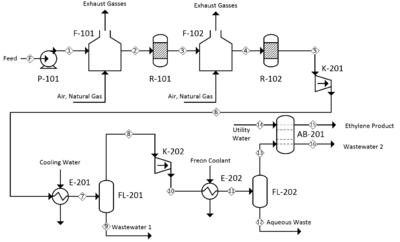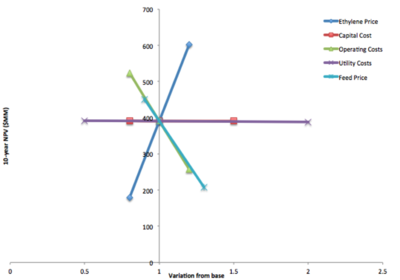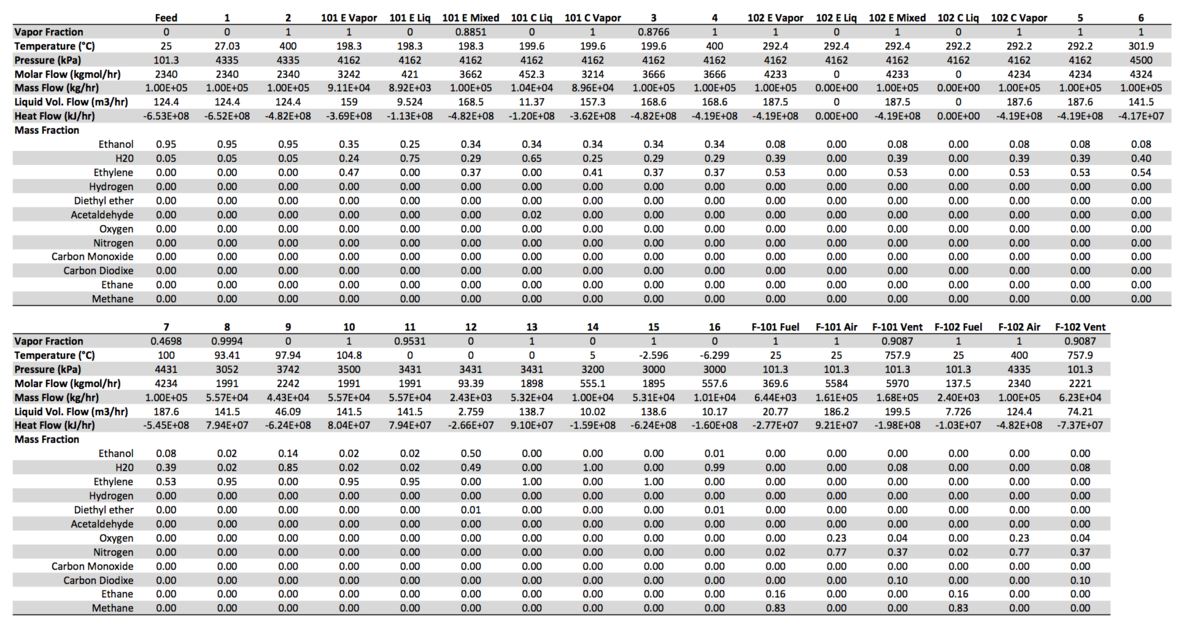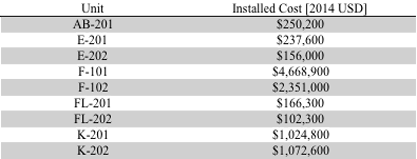Ethanol to Ethylene (B1): Difference between revisions
| Line 13: | Line 13: | ||
=Technical Approach= | =Technical Approach= | ||
Many bioethanol plants are located in the Midwest where large amounts of feedstock crops, such as corn, are grown. As such, this plant will be located in Story county, Iowa, near a large-scale bioethanol production plant. (DuPont Nevada Site, 2012) It is assumed that the supply of bioethanol is consistent and readily available. It is also assumed that other reagents - namely, the aluminum oxide catalyst, heater fuel, utility water and freon refrigerant - are readily available, and that wastewater treatment facilities are located near enough to facilitate the off-site treatment of wastewater. Plant capacity was based on current mid-sized industrial ethylene plants. (Designing Ethylene Plants, 2014) | |||
HYSYS simulations were performed with the NRTL fluid package and Peng-Robinson vapor model. The NRTL fluid package is an activity coefficient model that is especially useful to model the separations of alcohols in aqueous solutions. (Suppes, 2015) In addition, NRTL uses models of binary pairs of components, much like the Wilson equation, to predict chemical interactions at the molecular level. The NRTL package can thus be easily extended to ternary and higher order chemical systems, making it ideal for this type of simulation. The Peng-Robinson vapor model was selected as it is well-suited to account for the non-idealities of the vapor phase reactions and separations integral to this process. (ASPENtech, 2014) | |||
It was assumed that the feed enters the process at ambient temperature and pressure (25 °C, 1 atm) and at a consistent rate and composition with negligible quantities of impurities. The ethanol feed was assumed to be 95% ethanol and 5% water by mass, which is the commercial standard for industrial ethanol. (190 Proof Ethanol, 2012) Storage vessels for the feed ethanol, waste streams and products are assumed to be located nearby to the process. An initial feed pump compensates for pressure drops through the process and reduces the duty on downstream compressors. (Hadawey, 2015) | |||
Natural gas, assumed to consist of 83% methane, 16% ethane and 1% nitrogen by mass, was supplied to two fired heaters at a flow rate estimated by HYSYS. (Methane, 2015) Air fed to the process to enable combustion was assumed to be 23% oxygen and 77% nitrogen by mass. (Composition of Air, 2015) Air streams were fed at 50% molar excess in order to ensure complete combustion and prevent the formation of carbon monoxide in the heater exhaust. Total flue gases are assumed to be 230,000 kg/hr, or 2.2 million tons annually, and consist of 73.8% nitrogen gas, 10.5% carbon dioxide, 8.2% water vapor, and 7.5% oxygen by mass. The only compound of concern in these emissions is the carbon dioxide, a known greenhouse gas. At the time of this report, the quantities of carbon dioxide emitted by this plant annually are within acceptable EPA specifications. (Summary of the Clean Air Act, 2015) | |||
Due to the difficulty of simulation equilibrium and conversion reactions in a single vessel in HYSYS, these two reaction types were simulated in separate equilibrium reactor and conversion reactor units in series. In addition, while HYSYS indicated that reactor units would output separate vapor and liquid streams, it was assumed that in practice this would take the form of a single, two phase stream between each unit. To account for this, mixers were installed downstream of each reactor to combine the liquid and vapor phases of the reactor effluent. The three consequent reactions considered are as follows: | |||
Ethanol ↔ Ethylene + Water | |||
Ethanol → Acetaldehyde + Hydrogen | |||
2 Ethanol → Diethyl Ether + Water | |||
The optimal reaction temperature was determined to be 400 °C, which promotes the equilibrium reaction of ethanol to ethylene while minimizing byproducts. (Zhang and Yu, 2013) While other byproducts may be produced in this process, these reactions are typically taken to comprise of the bulk of the dehydration reaction. Heat losses over these reactors were assumed to be negligible. (Zhang and Yu, 2013)All major process equipment is assumed to be constructed of high strength carbon steel. (AspenTech, 2012) | |||
The “Sizing Utility” within the Icarus Economic Evaluation module was used to estimate sizes of major equipment based on the process simulation. These values can serve as a benchmark for an initial plant design. Icarus KbaseTM implements a wide variety of mechanical design standards, including ASME and BS5500, in order to calculate accurate equipment sizing. The Icarus sizing module combines equipment prices for standard chemical processing equipment as well as correlations and sizing factors. The advantage of using a software package such as HYSYS to price out individual equipment is that it utilizes up-to-date prices from vendors and distributors when estimating costs. A more in-depth overview of the correlations included in this software can be found in Towler and Sinnott (2009). | |||
=Process Flowsheet= | =Process Flowsheet= | ||
[[File:Squarepfd_B1.PNG|thumb|400px]] | [[File:Squarepfd_B1.PNG|thumb|400px]] | ||
Revision as of 04:14, 14 March 2015
Executive Summary
The following report outlines the design and analysis of a process converting ethanol to chemical-grade ethylene via catalytic dehydration. This process consumers 100,000 kg/hr of 95 wt% ethanol, 5 wt% water feedstock and produces 53,000 kg/hr of 99.7 wt% chemical-grade ethylene. The ethanol feed passes through two fixed-bed reactors, each packed with an aluminum oxide catalyst, and the resulting ethylene is purified by two flash tanks and by absorption with water. The process was modeled using Aspen HYSYS simulation software to estimate mass and energy flows and equipment sizing requirements. Based on results of this initial simulation, several alternatives are discussed for increasing the process efficiency and profitability. The use of a fluidized bed reactor or a more ethylene-selective catalyst could increase the production of ethylene per ethanol basis. Additionally, several methods of purification to more valuable polymer-grade ethylene are proposed.
The economic feasibility of this process was evaluated using Aspen Economic Analyzer with the Icarus economics package. Capital cost is approximately $16.4 million total with an operating cost of $465 million per year. The current market prices of the ethanol feed and ethylene sales price are $1.44/gallon and $1350/metric ton respectively. The cost of feed ethanol, process utilities and miscellaneous operational costs total to about $427 million/year. At full operation, revenue at current prices would be approximately $640 million per year. The predicted 10-year net present value of the process is approximately $391 million with an IRR of 79% and a payback period of 2.7 years. A sensitivity analysis indicates that the process is most sensitive to feed prices, product prices and operation cost.
Several recommendations are made for both cost reduction and profit maximization, including the design of a heat exchanger network and the optimization of fired heaters that require high capital investment and large amounts of fuel. A safety review of the process is recommended, as well as the minimization of flue gas effluent and wastewater. It is also suggested that the construction of an onsite wastewater treatment center be considered. Overall, the initial analysis indicates this to be a profitable process and it is recommended the project move forward.
Introduction
Ethylene is a critical chemical precursor to a number of different industrial products. It is often derived from petroleum sources and polymerized to polyethylene, one of the most ubiquitous plastics today. (American Chemistry Council, 2013) Recently there has been a significant effort to develop production pathways utilizing biologically-derived feedstocks, such as corn or cellulosic ethanol, rather than traditional fossil-fuel sources. Ethylene can be produced from bioethanol via catalytic dehydration over an aluminum oxide catalyst. The proposed process converts 100,000 kg/hr of 95 wt% ethanol, 5% water feed to 53,000 kg/hr of 99.7% chemical-grade ethylene when operating at full capacity. This process was found to be economically viable with a 10-year net present value (NPV) of $131 million (2014 USD) and a payback period of approximately 2.7 years. This memo will detail the proposed process, as well as outline potential alternatives and economic viability of the project.
Technical Approach
Many bioethanol plants are located in the Midwest where large amounts of feedstock crops, such as corn, are grown. As such, this plant will be located in Story county, Iowa, near a large-scale bioethanol production plant. (DuPont Nevada Site, 2012) It is assumed that the supply of bioethanol is consistent and readily available. It is also assumed that other reagents - namely, the aluminum oxide catalyst, heater fuel, utility water and freon refrigerant - are readily available, and that wastewater treatment facilities are located near enough to facilitate the off-site treatment of wastewater. Plant capacity was based on current mid-sized industrial ethylene plants. (Designing Ethylene Plants, 2014)
HYSYS simulations were performed with the NRTL fluid package and Peng-Robinson vapor model. The NRTL fluid package is an activity coefficient model that is especially useful to model the separations of alcohols in aqueous solutions. (Suppes, 2015) In addition, NRTL uses models of binary pairs of components, much like the Wilson equation, to predict chemical interactions at the molecular level. The NRTL package can thus be easily extended to ternary and higher order chemical systems, making it ideal for this type of simulation. The Peng-Robinson vapor model was selected as it is well-suited to account for the non-idealities of the vapor phase reactions and separations integral to this process. (ASPENtech, 2014)
It was assumed that the feed enters the process at ambient temperature and pressure (25 °C, 1 atm) and at a consistent rate and composition with negligible quantities of impurities. The ethanol feed was assumed to be 95% ethanol and 5% water by mass, which is the commercial standard for industrial ethanol. (190 Proof Ethanol, 2012) Storage vessels for the feed ethanol, waste streams and products are assumed to be located nearby to the process. An initial feed pump compensates for pressure drops through the process and reduces the duty on downstream compressors. (Hadawey, 2015)
Natural gas, assumed to consist of 83% methane, 16% ethane and 1% nitrogen by mass, was supplied to two fired heaters at a flow rate estimated by HYSYS. (Methane, 2015) Air fed to the process to enable combustion was assumed to be 23% oxygen and 77% nitrogen by mass. (Composition of Air, 2015) Air streams were fed at 50% molar excess in order to ensure complete combustion and prevent the formation of carbon monoxide in the heater exhaust. Total flue gases are assumed to be 230,000 kg/hr, or 2.2 million tons annually, and consist of 73.8% nitrogen gas, 10.5% carbon dioxide, 8.2% water vapor, and 7.5% oxygen by mass. The only compound of concern in these emissions is the carbon dioxide, a known greenhouse gas. At the time of this report, the quantities of carbon dioxide emitted by this plant annually are within acceptable EPA specifications. (Summary of the Clean Air Act, 2015)
Due to the difficulty of simulation equilibrium and conversion reactions in a single vessel in HYSYS, these two reaction types were simulated in separate equilibrium reactor and conversion reactor units in series. In addition, while HYSYS indicated that reactor units would output separate vapor and liquid streams, it was assumed that in practice this would take the form of a single, two phase stream between each unit. To account for this, mixers were installed downstream of each reactor to combine the liquid and vapor phases of the reactor effluent. The three consequent reactions considered are as follows:
Ethanol ↔ Ethylene + Water Ethanol → Acetaldehyde + Hydrogen 2 Ethanol → Diethyl Ether + Water
The optimal reaction temperature was determined to be 400 °C, which promotes the equilibrium reaction of ethanol to ethylene while minimizing byproducts. (Zhang and Yu, 2013) While other byproducts may be produced in this process, these reactions are typically taken to comprise of the bulk of the dehydration reaction. Heat losses over these reactors were assumed to be negligible. (Zhang and Yu, 2013)All major process equipment is assumed to be constructed of high strength carbon steel. (AspenTech, 2012)
The “Sizing Utility” within the Icarus Economic Evaluation module was used to estimate sizes of major equipment based on the process simulation. These values can serve as a benchmark for an initial plant design. Icarus KbaseTM implements a wide variety of mechanical design standards, including ASME and BS5500, in order to calculate accurate equipment sizing. The Icarus sizing module combines equipment prices for standard chemical processing equipment as well as correlations and sizing factors. The advantage of using a software package such as HYSYS to price out individual equipment is that it utilizes up-to-date prices from vendors and distributors when estimating costs. A more in-depth overview of the correlations included in this software can be found in Towler and Sinnott (2009).
Process Flowsheet
Economic Analysis
Process Alternatives/Recommendations
Conclusion
References
[1] American Chemistry Council. Production of chemicals and plastics in the U.S. in 2013, by type (in 1,000 metric tons). In Statista - The Statistics Portal. August 2014. Available at http://www.statista.com/statistics/299725/total-us-plastics-and-chemicals-shipments-by-type/, Accessed January 15, 2015. – Relative proportions of plastics production.
[2] DuPont Nevada Site Cellulosic Ethanol Facility [Internet]. DuPont Chemical; c2012-2015 [cited 11 Mar. 2015]. Available from: http://biofuels.dupont.com/cellulosic-ethanol/nevada-site-ce-facility/. -- Information on ethanol production in Iowa.
[3] Designing Ethylene Plants. Ethylene [Internet]. Technip; 2014 [cited 13 Mar. 2015]. Available from: http://www.technip.com/en/our-business/onshore/ethylene -- Plant size ranges.
[4] Suppes GJ. Selecting Thermodynamic Models for Process Simulation of Organic VLE and LLE Systems. The University of Missouri-Columbia, Dept of Chemical Engineering. [cited 13 Mar. 2015]. -- Use of NRTL in alcohol separations.
[5] ASPENtech. Appendix A - Property Methods and Calculations. Simulation Basics; A-3 - A-26. 2014.
[6] 190 Proof Ethanol: Technical Data Sheet [Internet]. Decon Labs Inc; 2012 [cited 13 Mar. 2015]. Available from: http://www.deconlabs.com/tds/ETHANOL%20190%20%20PROOF.pdf -- Information regarding 95% ethanol
[7] Hadawey A, Ge Y, Tassou TSA. Energy Savings Through Liquid Pressure Amplification In A Dairy Plant Refrigeration System. The Centre for Energy and Built Environment Research [cited 13 Mar. 2015].
[8] Methane (Chemical Compound). 2015. Encyclopædia Britannica Online. [cited 13 Mar. 2015] Available from: http://www.britannica.com/EBchecked/topic/378264/methane -- Composition of Methane
[9] Composition of Air [Internet]. Engineering Toolbox; [cited 13 Mar. 2015]. Available from: http://www.engineeringtoolbox.com/air-composition-d_212.html. -- Composition of air.
[10] Summary of the Clean Air Act, 2015. United States Environmental Protection Agency. [cited 13 Mar. 2015] Available from: http://www2.epa.gov/laws-regulations/summary-clean-air-act -- Emissions requirements of chemical plants.
[11] Zhang M, Yu Y. Dehydration of Ethanol to Ethylene. Industrial Engineering and Chemical Research. 2013; 52:9505-9514. – Technical information on ethanol to ethylene conversion via dehydration.
[12] AspenTech. Aspen HYSYS Help File v8.0. Aspen Technology, Inc. 2012. - Aspen HYSYS help file used for troubleshooting and assistance on economic analysis.
[13] Towler G, Sinnott R. Chemical Engineering Design: Principles, Practice and Economics of Plant and Process Design. 2nd ed. Boston: Elsevier; 2013. -- General Reference Book
[14] Barrocas H, Baratelli F, inventors; Petroleo Brasileiro S.A., assignee. Process for dehydration of a low molecular weight alcohol. US patent 4,396,789 A. August 2, 1983. - Primary background for process design.
[15] Tsao U, Zasloff HB, inventors; The Lummus Company, assignee. Production of ethylene from ethanol. US patent 4,134,926. January 16, 1979. – Patent for catalytic dehydration of ethylene in a fluidized bed reactor.
[16] Morschbacker, A. Bio-Ethanol Based Ethylene. Polymer Reviews. 2009; 49:79-84. – Overview of bioethanol dehydration process development.
[17] Fan D, Dai DJ, Wu HS. Ethylene Formation by Catalytic Dehydration of Ethanol with Industrial Considerations. Materials. 6, 101-115. doi: 10.3390/ma6010101. - Comparison of types of catalysts used in the dehydration of ethanol and current research into new catalysts.
[18] Chen G, Li S, Jiao F, Yuan Q. Catalytic dehydration of bioethanol to ethylene over TiO2/γ-Al2O3 catalysts in microchannel reactors. Catal. Today 2007, 125, 111–119. - Paper introducing research on modified alumina catalyst for ethanol dehydration.
[19] Jumonville, J. Tutorial on Cryogenic Turboexpanders. Proceedings of the Thirty-Ninth Turbomachinery Symposium; 2010 Oct 4-7; Houston, TX. Houston: Texas A&M University; 2010. -- Use of turboexpander for cryogenic separations
[20] Today in Energy - Daily Prices. US Energy Information Administration website. http://www.eia.gov/todayinenergy/prices.cfm. Accessed March 3rd 2015. - Bulk market price for 95% ethanol.
[21] Weddle, N. ICIS Pricing: Ethylene (Europe). Reed Business Limited. January 10 2014. - Bulk market price for chemical grade ethylene.
Appendix I - Process Flow Diagram
Appendix II - HYSYS Simulation
Appendix III - Material Streams
Appendix IV - Energy Table
Appendix V - Economics









